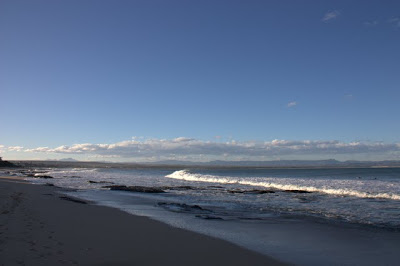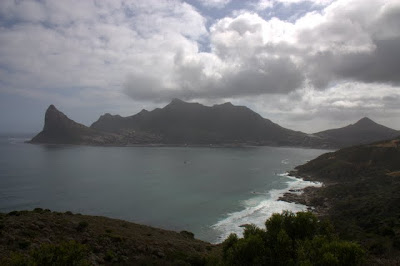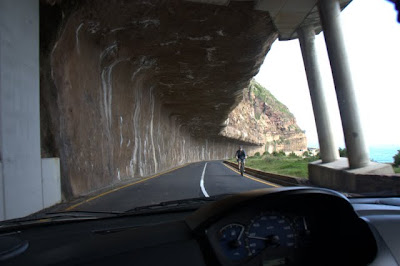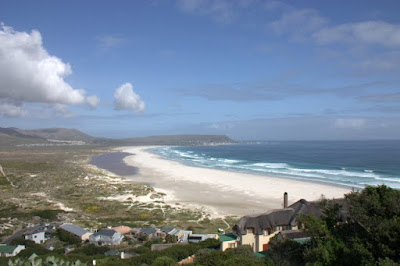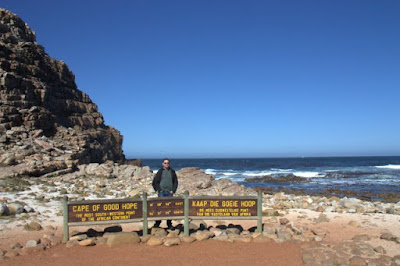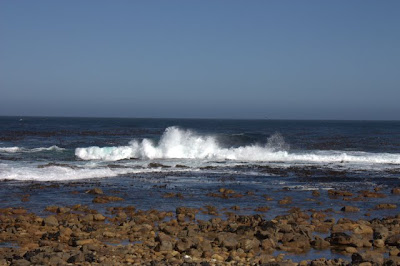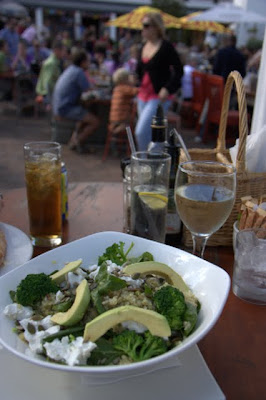You’ve got to roll with it.
Like days at home, there’s good and there’s bad on the road. The pendulum can swing back and forth pretty quickly. I know that technically I am not allowed to complain about anything, on account of the not having to work thing, but it is what I do best.
Good: tracking lions on safari. Obviously a great start to a day.
Good: looking at beautiful scenery in Blyde River Canyon.
Bad: adding a new category to our budget – shakedown fees – after a police officer kindly suggests that a small donation to his wallet would be a win-win for all involved instead of a more costly speeding ticket.
Bad: everything affordable in Graskop, where we planned to stay, is booked.
Good: there’s delicious pancakes in Graskop. Very good. Very good, indeed.
Good: finding a spring stone sculpture in a local artist’s shop with resident kitties.
Bad: discovering, after it is too late and dark to bother finding another, that the hostel room recommended in our guidebook in the next town over is basically a glorified room in someone’s garage.
Just another day on the road.
Supertubes, Dude
In the 1960s, surfers discovered the perfect wave in Jeffreys Bay, South Africa, turning the sleepy beach town into a surfers’ haven.
Jeffreys Bay is now regarded as one of the top five surfing destinations in the world. Each year, Jeffreys Bay is host to the annual Billabong Pro ASP World Tour surfing event. The waves in Jeffreys Bay have one of the most consistent and quality right hand point breaks in the entire world. The Supertubes, which break for about 300 meters or more, are regarded as the best of the best.
It had been raining all day when we arrived in Jeffreys Bay. Suddenly, the rain stopped, and a rainbow appeared over Supertubes Beach.
Shortly thereafter, we watched all of the surfers staying in our guesthouse frantically grab their wetsuits and boards, rushing to the beach to catch some waves before the sun went down.
Despite Sean’s ability to actually get up on a surfboard (demonstrated on our honeymoon in Hawaii five years ago), we just watched the surfers work the Supertubes in the late afternoon sun. Even I could tell the waves were perfect for surfing. Long and tubelike – hence the name – the Supertubes allow the surfers to ride the wave horizontally to the beach for a good distance.
As much as we liked Jeffreys Bay, we had no plans to return anytime soon. The night after we stayed in Jeffreys Bay, we stopped in East London for the night before our planned drive up the Wild Coast the next day. It wasn’t until we reached East London that I realized that I forgot my trail running shoes at our guesthouse in Jeffreys Bay. Oops. Kind of an important item when you are travelling for a year. We were already on a tighter schedule than we would have liked due to our lack of planning, but we agreed we had no choice. We would have to cut our Wild Coast plans short by one day, make the 3 1/2 hour drive the next day to Jeffreys Bay to retrieve my shoes, and then drive 3 1/2 hours back to East London for the night. Not the best day of our trip, but at least there was a silver lining. Returning to Jeffreys Bay meant we got to eat lunch again at Wax Cafe. Wax Cafe is a fun little place with good food and that chill surfer vibe. It shows videos of surfers on the Supertubes and lists the daily surf report on the chalkboard out front.
This would be our third meal there in two days – it was that good. Our favorite waitress, the same one who had waited on us for our previous lunch and breakfast, was very confused to see us again. If you ever find yourself in Jeffreys Bay, check it out.
Scenes from Cape Point
One of the highlights of Cape Town is not in Cape Town itself, but on Cape Point, the peninsula that juts into the Atlantic and Indian Oceans. I loved both of the day trips we spent exploring Cape Point. The scenery on Cape Point is amazing: beaches, cliffs, mountains, wild flowers.
We hiked up to the lighthouse on Cape Point for amazing views, and stood at the southwestern-most point of Africa at the Cape of Good Hope.
I saw a guesthouse at which I want to stay if I am ever on Cape Point again.
Each day we visited, we ate lunch at a different farm and craft village, where we drank local wine, ate organic food, and soaked up the sunshine. It was late August – the equivalent of late March at home – and spring was in the air.
All of this, not to mention all of the animals we saw…coming soon!
European Wrap-up, Rants and Raves
When we first arrived in Europe on March 31, it felt very much like a foreign land. We spent many days alternating between a state of confusion and wonderment. We were only supposed to spend three months in Europe, but ended up staying just shy of four months. Some time during our four month stay – probably when we escaped back to Spain after having a tough time in Morocco after getting ill – we came to view Europe as more familiar than foreign, no matter what the country or the language. Sure, every country is unique, but every country we visited is fundamentally Western. Once we adjusted to travelling somewhere that we couldn’t speak the language – which admittedly is still difficult and frustrating at times – everything else fell into place.
We traded going to Europe for going to South America, which we’ll save for the future. Going to Europe definitely ate into our travel budget much, much more than if we had gone to South America, but it was worth it. We had never been to Europe before. The European countries have had and do have such a dominant influence on the rest of the world that it would be difficult for us to understand other countries and cultures without first experiencing Europe itself. We tried to minimize costs by going to countries that are rumored to be less expensive – Spain, Portugal, Czech Republic, Slovenia, Croatia, Hungary, and Poland. None of those countries were as cheap as we hoped, but costs are definitely lower than some European countries. We did slip in a few countries with higher costs – France, Germany, Belgium, Ireland, and Northern Ireland – but tried to counterbalance those costs in France and Germany by staying with friends and in Germany and Belgium by only staying a short time. If you missed it, I posted about our average daily cost to travel through Europe yesterday.
Even with four months, we barely scratched the surface of Europe. I know we will be back someday – I still need to eat my way through Italy after all. As we move on to the rest of the world, I thought I’d close out our experiences by sharing our rants and raves about Europe:
Raves
- Canine freedom. Dogs lead a much better life than in the United States. They seldom are leashed and typically have the freedom to roam courtyards, restaurants, and beaches.
- Lax liquor laws. Particularly because we live in Pennsylvania, one of the states with the strictest and asinine liquor laws (god forbid you buy a beer in a grocery store or drink outside in public!), we appreciated the freedom of Europeans to have a drink essentially whenever they want where ever they want.
- Plethora of bakeries. Even outside of Paris, where they elevate baking to an art form, much to the delight of my sweet tooth, bakeries can be found on almost every street. Besides providing constant dessert, the savory items, such as empanadas and the like, made for cheap eats.
- Free time. While it endlessly confused as to why no one ever appeared to be working, Europeans’ love of sitting around in cafes and in parks, doing nothing, fit in well with our new hippie, jobless lifestyle. Once we return to the States and re-join the “real world,” I need to remember to incorporate in more time to perfect the art of doing nothing. I think it does wonders for the soul.
- Runaway trains. The ease of train travel in Europe is amazing. Small towns, big cities, new countries: you can reach almost every place in Europe by train. It is hard to suppress the urge to keep on rollin’ when it is as easy as going to the center of town and hopping on board.
- Urban love. Most European cities have compact city centers. Life is centered in the middle, and radiates out from there. There are no such thing as a true suburb in Europe. There is just the city, the outskirts, and the country. The cities are full of life. This is most likely related to a corollary love: ease of getting around. Most European cities can be traversed by foot or by amazingly efficient public transit systems. Transit for the masses in Europe is the polar opposite of the Pittsburgh Port Authority. Most cities have subways or trams. Even buses are better: most have digital read-outs at the bus stop indicating how long you’ll be waiting for the next bus. Having a car in not necessary in many countries, and in fact, can even be a hindrance in many of the cities.
- Blurred edges of different cultures. I love that crossing borders is as easy as crossing into different states. Because each country has its own language, food, and customs, it never lost its luster to change countries. Most jarring, and exciting, was the flights we took, which meant we switched from Spanish culture to Czech culture in the same day or, later, from Polish culture to Irish culture. But just as interesting was travelling overland, where you could watch separate cultures swirl together, always retaining their own subtle differences.
- European green. Throughout Europe, we spotted solar energy, windmills, and recycling bins, which made my tree-hugger heart happy.
- No need for a DVR. Though it is rare that I watch a commercial at home anymore due to the world’s greatest invention, you still can’t avoid them, such as during a live sporting event. We met a German woman living in Portugal who just could not wrap her head around the number of commercials in the United States. After watching television in Europe, I’m with her. It is nice, however, to have an occasional commercial during a sporting event for a bathroom or snack break. No need for one after practically every play, like American football, but I don’t have the undivided attention span required to watch European football!
- Beautiful things all around. Between the architecture and green spaces, your eye always has somewhere to linger.
- Disappearing taxes. If I had to pay as much tax as the Europeans do, I wouldn’t want to see it all broken down either. Prices in Europe already comes with the tax included, which makes it easier to figure out how much damage you are doing to your wallet.
- No tip jars for performing your job. Tipping culture in the United States can get out of control at times. Tip jars in Europe are a rare sight. Waiters and waitresses are paid better than their U.S. counterparts, so tips in Europe are either nonexistent or drastically reduced.
- Living life outside. One of the worst things about working is shuffling between a dark, stuffy office and a dark, stuffy restaurant for lunch on a nice, sunny day. There is never enough outdoor seating at home, but this is not a problem in Europe. People live their lives outside: with open, screenless windows; at outdoor cafes and restaurants; in public squares and parks.
- Markets. It is typically not hard to find farmers and artisanal vendors selling their wares in a market.
- No unnecessary 9.99s. The jig is up; we all know 9.99 is really basically $10. The Europeans don’t try to fool us and just charge flat amounts.
- Casual breeziness. Even in fancy Paris, women always looked so pulled together in a casual, understated way. No sweatpants in public here.
- Appreciation of eating and drinking. I’ve alluded to this above, but Europeans in general have a sincere appreciation for food and drink. My taste buds were happy there.
Rants:
- Smoky hazes. Although some countries are getting on board with smoking bans in public buildings, the smoking habit in Europe is alive and well.
- Tiny drinks. This was particularly Sean’s pet peeve. The drinks in Europe are absurdly tiny, leaving us constantly thirsty. We agree that supersizing is excessive, but how do they get away with charging 3 or 4 euros for a 6 oz. coke?
- Is this the Sahara desert or something? As a corollary to the rant above, contributing to our constant thirst was the fact that very, very few restaurants served tap water and insisted upon making you pay for fancy – and often tiny – bottled water. My favorite is when we would be told that they flat out did not have tap water. Right. If we would get tap water, the chances of getting a refill was slim to none. Related is the Europeans’ love of sparkling mineral water and my corresponding hatred of the same. Sean still laughs at the memory of me uncouthly spitting out mineral water on the sidewalk on a 90 degree day when we couldn’t figure out, for the second bottle in a row, what meant still water in Hungarian.
- Lack of customer service. Although our pocketbooks liked our love of tipping less, this all too often was accompanied by little desire to please the customer. See note about no refills of water, above. We quickly understood the cultural difference of needing to ask for the check, but never got used to being completely ignored once the food arrived.
- Sleeping like old people. We probably had one queen bed the whole time we were there; otherwise it was two twins pushed together. Although, I think Sean actually secretly liked having more room in a bed to himself.
- Runaway shower heads. I cannot stand the hand-held shower head. When there was a holder than worked, they weren’t that bad, just less water pressure than I’m used to. The rest of the time, I never could figure out where you are supposed to set the shower head whenever you did anything else, such as wash your hair. I’ve squirted many ceilings, walls, and my eyes when the shower head, ever so carefully laid in a resting place to soap up, suddenly surge with water.
- Confounded locks. While the old-fashioned keys are cool to look at, use of them befuddled me 9 times out of 10.
- Lack of air conditioning. I know that old buildings make retrofitting them for air prohibitively expensive, and excessive use of air is bad for the environment, but there is NO respite from heat in certain cities in the dead of summer – not even in the grocery store or restaurants, two notoriously freezing places at home. When there is air, it is usually a room unit, extremely undersized, that chugs weakly in a huge space with open doors and windows.
- Tiny, tiny, tiny Speedos. Not an original rant, I know, but really – why?
- Subpar chiclet. When I was an office drone, I chewed an excessive amount of gum. I haven’t completely broken the habit, but the tiny, hard pieces of gum will likely help. Where is the spearmint Orbit when you need it?
- Never having exact change, yet always having a ton of coins. Without fail, every time we tried to pay for something in cash, the cashier would declare our tender to be too large and request exact change. Nothing is ever good enough. Once I tried to pay for a 19 euro bill with a 20 and was rebuffed and interrogated about the change in my possession. Yet, because of the 1 and 2 euro coins, we were constantly weighed down. On a related note, if I had a euro for every time the machines at places that purportedly accepted credit cards was mysteriously “broken,” I wouldn’t need to use credit cards at all.
- Paying crazy taxes as a tourist. I know someone’s got to pay for all of the fabulous things in Europe, and you can sometimes get a refund on big-ticket purchases, but ouch! No wonder they bury all of the taxes.
- Graffiti. For some reason, many of the beautiful things in Europe are covered in ugly, messy graffiti. It makes me sad such beautiful, historic items are ruined.
- 80s on steriods. For the life of me, I cannot understand why anyone would wear those baggy, droopy pants that sag in the butt and crotch and taper at the ankles. They didn’t look good on MC Hammer, and not even skinny European girls can pull them off now. Please, for the love of God, tell me that these have not made an appearance in the United States. Please.
So there you have it! Traveling in Europe is a fabulous experience. I can’t wait to go back someday, but it was great to move on after spending so much time there. Stay tuned for posts about South Africa and Jordan in the weeks to come, then it is Asia time!
Pierogi Bender
Being from Pittsburgh, I am well versed with the pierogi. Pittsburgh is a city with many neighborhoods still filled with the descendants of the Central European immigrants who settled there many years ago. It even has an entire hill devoted to the Polish – creatively named Polish Hill. So Sean and I were eagerly anticipating tasting actual Polish pierogies. I’ll admit it – there were days in Krakow when I ate pierogies for lunch and dinner. They are filling, cheap, and delicious. What’s not to love? Probably all of the calories due to the fact they were most frequently served swimming in lard.
Krakow has a 24 hour pierogie place. This is a fantastic idea. I am not sure why someone in Pittsburgh has not thought of this. It would be perfect on the South Side and would give that dog kebab place a run for its money. It fits well in Krakow, which appeared to have lots of young party-goers. Being old farts ourselves, we visited Zapiecek Polskie Pierogarnia for lunch.
We started with the basics. The most common pierogi in Krakow was the pierogi ruskie, also known as a Russian pierogi. Pierogies ruskie were filled with potato and cottage cheese and had a rather creamy texture.
That same night, we tried pierogies at U Babci Maliny, an obnoxiously ornate restaurant that was redeemed by their excellent pierogies. Sean especially liked the beef and cabbage filled pierogies there.
We ventured out in the pouring rain the next day to try a milk bar, which is a cheap cafeteria style restaurant that was common during the communist area.
Almost everything in Krakow is in English, but not the milk bar. This made ordering very difficult. We finally saw a British family and asked what they ordered, and tacked on an order of pierogies ruskie for good measure. The pierogies at the milk bar were surprisingly tasty, and cheap to boot.
Our final pierogie tasting was the most adventurous. Pierożki u Vincenta, located in the Jewish neighborhood, has fun and creative pierogi fillings. We sampled the sundried tomato and mozzarella filled pierogies, but the sweet pierogies we ordered stole the show. They were filled with grilled plums and cinnamon, and were scrumptious.
I think it is possible for me to subsist on a diet consisting primarily of pierogies forever. Luckily for us, the Polish store in the Strip District at home will keep us filled with pierogies when we finally make it home.
P.S. Those travelling to Krakow with a sweet tooth and a slight case of homesickness should be sure not to miss the cookies and brownies baked up by an American ex-pat at More Than a Cookie.
Nor should one miss the cupcakes at Cupcake Corner, which have actual substance as well as style. According to an article I read Cupcake Corner is apparently known as the Polish Magnolia Bakery a la Sex in the City after they were featured in a Polish television show. Personally, I think the Polish picked up the American cupcake thing quite well, for their cupcakes were even tastier than Magnolia’s cupcakes.





